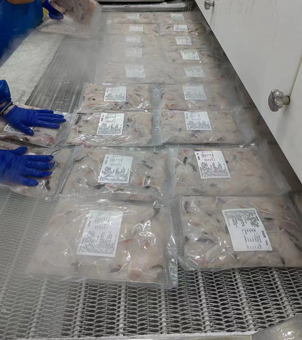In the modern food industry, freezing technology is essential for protecting product quality, extending shelf life, and maintaining efficient production. As consumers demand safer and higher-quality food, manufacturers are looking for freezing systems that are faster, cleaner, and more reliable. Among the available options, tunnel freezers and batch freezers are two widely used choices. Yet, more processors are shifting toward tunnel freezers. Why is this happening?
The sections below explain the main differences and show why tunnel freezers are becoming the preferred solution.
1. What Are Tunnel Freezers and Batch Freezers?
Before comparing them, it is helpful to understand how each system works.
Tunnel Freezer
A tunnel freezer operates continuously. Products move through a long, enclosed tunnel on a conveyor belt while very cold air — often cooled by liquid nitrogen — quickly freezes them. Because the process is fully automated, it fits large-volume, high-speed production.
Liquid nitrogen freezing is extremely fast, which helps protect the natural texture, nutrients, and flavor of the food.
Batch Freezer
A batch freezer works in cycles. Each batch of food must be placed into the chamber manually, frozen, then taken out before the next batch starts. This stop-and-start process requires more labor and takes more time.
These units may use mechanical refrigeration or liquid nitrogen, but freezing generally happens at a slower pace, which can lead to uneven results.
In short, tunnel freezers support continuous automated production, while batch freezers suit small or specialized runs.
2. Production Efficiency: Tunnel Freezers Keep the Line Running
Efficiency is a major concern for processors. Because tunnel freezers run nonstop, products enter and leave the system without interruption. This makes it possible to operate around the clock and significantly increase throughput.
For example, one seafood plant raised its daily output from 5 tons to 15 tons after switching to a tunnel freezer — a three-fold improvement.
Batch freezers, however, must be stopped for loading and unloading each cycle. These breaks reduce output, require more labor, and make it harder to keep up during busy seasons. Studies show companies using batch freezers often produce 30%–50% less compared with those using tunnel systems.
Tunnel freezers can also connect directly to upstream equipment, such as sorting or cutting machines, creating a smooth, automated production line. Batch freezers normally operate independently, causing extra handling and delays.
3. Food Quality and Consistency: Tunnel Freezers Freeze Faster and More Evenly
Quality is one of the biggest reasons manufacturers upgrade to tunnel freezing. Liquid nitrogen tunnel freezers lower the core temperature of food to -18°C or below very quickly. This rapid cooling stops large ice crystals from forming, which helps maintain:
Original taste and texture
Nutritional value
Natural color
Vegetables stay crisp, and meat stays juicy after thawing.
Batch freezers cool products more slowly. The surface may freeze first while the center freezes later, which may cause:
Cell damage
Water loss
Texture changes
Quality differences between batches
Tunnel freezers provide stable temperature and airflow throughout the tunnel, ensuring every piece receives the same freezing conditions — a key requirement for consistent production and brand reputation.



4. Cost Savings: Tunnel Freezers Lower Operating and Labor Costs Over Time|
Although the initial investment is higher, tunnel freezers generally offer better long-term value.
Lower labor cost
One or two operators can run an entire tunnel freezer line. Batch freezers need more workers because of frequent loading, unloading, and cleaning.
Lower energy use
Rapid freezing with liquid nitrogen reduces the time required to reach the target temperature. This can lower energy consumption by 20%–30% per unit of product.
Lower maintenance cost
Tunnel freezers have fewer moving parts and tend to operate more reliably, reducing service needs and unexpected downtime.
Batch freezers often come with hidden costs such as long cleaning times, more repairs, and additional labor.
5. Flexibility and Capacity Growth: Modern Tunnel Freezers Handle Multiple Needs
Some believe batch freezers are more flexible because they work well for smaller quantities. However, today’s tunnel freezers are designed to be highly adaptable.
Settings such as:
Conveyor speed
Tunnel temperature
Airflow direction
Tunnel length
can all be adjusted easily. Many newer models also allow quick product changeovers, making them suitable for seasonal or mixed production.
Batch freezers are difficult to scale. When demand grows, factories may need several units, taking up space and complicating production management. Tunnel freezers can expand simply by adding modules or extending the tunnel, making them more suitable for growing businesses.
6. Hygiene and Safety: Tunnel Freezers Offer Better Sanitary Control
Food safety is critical. Tunnel freezers are usually built with 304 stainless steel and smooth internal surfaces that are easy to clean. The enclosed tunnel design minimizes contact with external environments, greatly reducing contamination risks.
Batch freezers need workers to handle products frequently, which increases the possibility of:
Bacterial contamination
Temperature variation
Incomplete cleaning
Microbial growth
Tunnel freezers also support better traceability and meet international hygiene standards more easily — a major advantage for exporters.
Tunnel Freezers Offer Clear Advantages
When comparing efficiency, product quality, operating cost, expansion potential, hygiene, and long-term benefits, tunnel freezers consistently perform better than batch freezers. For processors aiming for higher output, stronger food safety control, and more stable operations, tunnel freezers are a smarter long-term investment.
Even though the purchase cost is higher, the improvements in productivity and product quality often lead to a quick return on investment.
If you are considering upgrading your freezing equipment, a tunnel freezer may help your business operate more efficiently and prepare for future growth.
